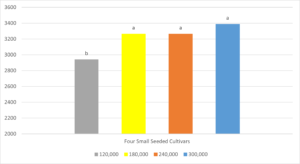Plant population studies from the 1980’s developed recommendations for narrow row production. Since that time, there have been dramatic changes in production practices including row width, market class selection, and the plant architecture of cultivars. Collectively, these changes should have a dramatic effect on grower decisions for plant populations for dry beans. Recent planting technology allows growers to change seeding rate in real time, to maximize yield and minimize cost. The purpose of this study was to determine the optimal plant population for small seed bean cultivars planted in 38 cm (15 inch) rows, across multiple environments in Ontario.
Six small plot studies tested navy (cv. Nautica, Rexeter, T9905) and black (cv. Zorro) beans at four seeding rates. The seeding rates were 120,000; 180,000; 240,000 and 300,000 seed/ha (approximately 48,500; 73,000; 97,000; and 121,500 seeds/ac) at Ridgetown, Exeter, and Blyth, ON. Measurements included plant growth and development at 40 and 60 days after planting, and crop yield.

As expected, a decrease in seeding rate resulted in an decrease in canopy height and an increase in plant dry weight. Seeding rate had no effect on plant stage of growth (e.g. flowering) at 40 or 60 days after planting, or seed weight at harvest. Crop yield was similar (Figure 1) for all four cultivars between 180,000 and 300,000 seed/ha. Only the seeding rate of 120,000 seed/ha reduced yield (by 13%) compared to the highest seeding rate.